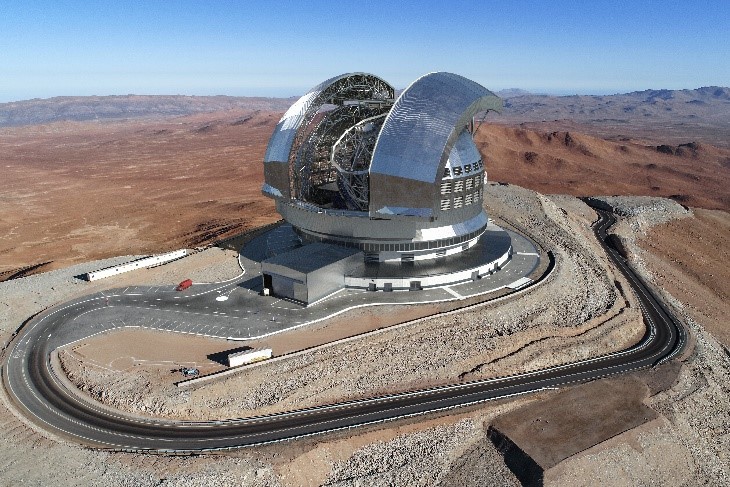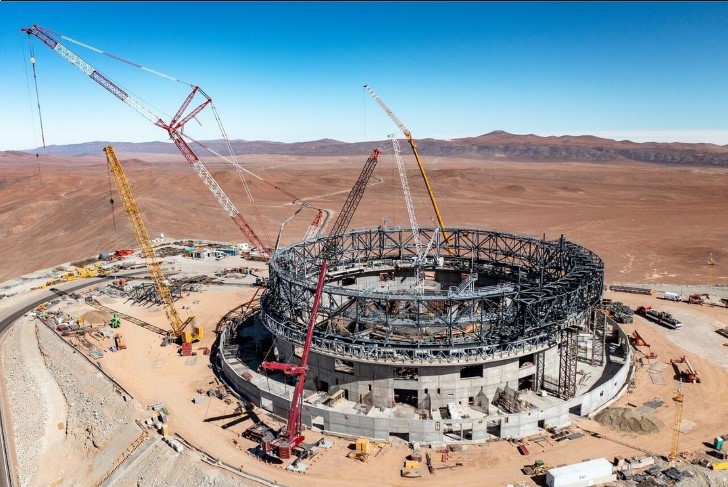AUTHOR: Michele Tabellini
TUTOR: Giovanni Franchi
INTERNSHIP: Cimolai S.P.A
MASTER: Master in “Project Management delle opere strutturali e infrastrutturali” a.a 2021/22
La pianificazione è l’aspetto principale su cui ruota questa tesi, di fatti quest’ultima può essere letta come un collegamento tra il mondo teorico del planning e quello pratico del cantiere, in cui vengono applicati gli aspetti teorici della pianificazione.
Il soggetto di questa tesi è l’European Extremely Large Telescope (E-ELT), che, come dice il nome stesso, sarà il telescopio ottico più grande mai costruito dall’uomo, nel deserto di Atacama in Cile (Figura 1). La tesi ripercorre quindi la storia del cantiere fino ad oggi, ripercorrendo gli avvenimenti principali del cantiere da quando è stata spianata la punta della montagna fino ad oggi, tutto attraverso informazioni pubbliche. Un parallelismo viene fatto attraverso l’analisi del predecessore dell’E-ELT: il Very Large Telescope (VLT), che venne inaugurato negli anni 2000 e che dista poche decine di chilometri dal campo base dell’E-ELT. I primi capitoli hanno quindi il compito da fare da introduzione al progetto e agli attori coinvolti, quali Cimolai come impresa principale e l’European Southern Observatory (ESO) come committente. La tesi prosegue poi analizzando i vari aspetti teorici della pianificazione, quali il ciclo PDCA (Plan-Do-Check-Act), la OBS ovvero le risorse coinvolte, le attività di cui si compone il progetto cioè la WBS ed infine il Diagramma di GANTT in cui i tempi e le attività si incontrano.
Il passo successivo riguarda più da vicino la pianificazione pratica, dando così un’istantanea sull’attività da Planner che svolgo quotidianamente in cantiere (Figura 2); suddividendo quindi la pianificazione in quella generale che ha una visione di anni, fino alla fine del cantiere, ed in quella di cantiere che ha un’ottica più mirata al breve periodo ed uno scopo più operativo.
In seguito alla prima fase di pianificazione viene spontaneo applicare il PDCA, ovvero il ciclo che prevede 4 fasi che si ripetono, ovvero: Plan – Do – Check – Act; per cui la pianificazione è il primo passo, ma solo attraverso un costante monitoraggio (check) del progetto è possibile intervenire in caso di imprevisti o di ritardi. I report giornalieri e settimanali di cantiere hanno il fine di monitorare costantemente, rispetto ad una baseline, gli avanzamenti dei lavori rispetto a quello pianificato. Tenendo traccia dei tempi impiegati per eseguire talune lavorazioni è possibile aggiornare in corso d’opera la pianificazione dei lavori e sapendo dove intervenire. Avere dei dati certi di partenza aiuta ad ottenere una pianificazione più accurata.
La pianificazione permette di prevedere con un certo grado di accuratezza, che va a diminuire all’aumentare del tempo, le attività da svolgere all’interno del cantiere. Tanto più è grande e complesso il cantiere, o il progetto da eseguire, tanto più esso richiede una pianificazione accurata delle diverse lavorazioni o attività, soprattutto se esse spesso avvengono in contemporanea. Oltre all’attenzione posta alle tempistiche al fine di realizzare quest’opera immensa, vanno tenute in considerazione anche le persone che ci lavorano: 250 lavoratori in pianta stabile; da qui nasce l’attenzione verso il tema del facility management, incentrato su tre aspetti: l’organizzazione, la gestione e i comfort. La lontananza dalla città più vicina (due ore d’auto) fa’ del facility management un tema molto importante all’interno di un accampamento così isolato (Figura 3), organizzare le forniture di acqua, garantire la connessione ad internet e l’elettricità diventano beni indispensabili per la sopravvivenza. Un’accurata gestione del campo base ci permette di continuare a lavorare così isolati, soprattutto considerando gli ultimi black-out della linea elettrica, superati solo grazie ad una previdente dotazione di una serie di generatori d’emergenza che hanno garantito all’intero accampamento di rimanere collegato con il mondo esterno. La gestione delle stanze, le pulizie, la lavanderia, la manutenzione oltre che alle attività ricreative per i lavoratori sono tutte aspetti del facility management che permettono di poter lavorare in un ambiente sano e di poter garantire una produttività che in assenza di queste attenzioni non si avverrebbe.
FOR INTERNATIONAL STUDENTS:
Planning is the main aspect on which this thesis revolves, in fact the it can be read as a link between the theoretical world of planning and the practical one of the construction site, in which the theoretical aspects of planning are applied.
The subject of this thesis is the European Extremely Large Telescope (E-ELT), which, as the name suggests, will be the largest optical telescope ever built by man, in the Atacama’s desert in Chile (Figure 1). The thesis therefore traces the history of the construction site until today, retracing the main events of the construction site since the mountain was leveled until the construction itself, all through public information. A parallelism is drawn through the analysis of the predecessor of the E-ELT: the Very Large Telescope (VLT), which was inaugurated in the 2000s and it is distant less than few tens of kilometers from the E-ELT base camp. First chapters therefore have the task of introducing the project and the actors involved, such as Cimolai as the main company and the European Southern Observatory (ESO) as the client. The thesis then continues by analyzing the various theoretical aspects of planning, such as the PDCA cycle (Plan-Do-Check-Act), the OBS that are the resources involved, the WBS that are all the activities of which the project is composed and finally the GANTT Diagram, where times and activities meet.
The next step concerns practical planning more closely, thus giving a snapshot of the Planner activity that’s carried out on the construction site every day (Figure 2); thus dividing the planning into the general one which has a global vision, up to the end of the construction site, and into the construction site one, which has a more focused perspective on the short term and a more operational purpose. Following the first planning phase, it is natural to adapt the PDCA, i.e. the cycle which includes 4 repeating phases: Plan – Do – Check – Act; planning is the first step, but only through a constant monitoring (check) of the project it’s possible to intervene in the case of unforeseen events or delays. The daily and weekly site reports are born in order to constantly monitor, with respect to a baseline the progresses of the works with respect to the planned one. By keeping track of the time taken to carry out certain activities, it is possible to update the planning of the works during the construction phase, knowing where to intervene thanks to accurate datas makes the planning more accurate.
Planning makes possible to predict with a certain degree of accuracy, which decreases as time increases, the activities to be carried out within the construction site. The bigger and more complex the construction site is, or the project to be carried out, the more it requires a careful planning of the various processes or activities, especially if they often take place simultaneously.
In addition to the attention paid to execute the works on time, it’s mandatory consider the people who work there, 250 workers on a permanent basis. From this aspect cames from the attention to the theme of the facility management, focused on three aspects: organization, management and comfort. The distance from the nearest city (two hours by car) makes facility management a very important aspect within such an isolated camp (Figure 3), organizing water supplies, guaranteeing internet connection and electricity become indispensable goods. An accurate management of the base camp allows us to continue working in isolation, above all considering the last black-outs of the electric line, overcome only thanks to a provident endowment of a series of emergency generators which guaranteed the entire camp to stay connected to the outside world. Room management, cleaning, laundry, maintenance as well as recreational activities for workers are all aspects that must be taken into consideration for the facility management; that allow us to work in a healthy environment and be able to guarantee a good level of productivity that would not occur without these attentions.



